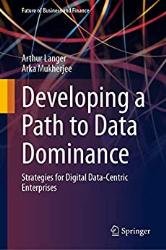 Название: Developing a Path to Data Dominance: Strategies for Digital Data-Centric Enterprises
Название: Developing a Path to Data Dominance: Strategies for Digital Data-Centric EnterprisesАвтор: Arthur Langer, Arka Mukherjee
Издательство: Springer
Год: 2023
Страниц: 291
Язык: английский
Формат: pdf (true), epub
Размер: 40.8 MB
Most existing companies struggle currently because they lack the tools and strategies to move product departments into independent platforms that can be retrofitted to form dynamic new products based on consumer demands. This book provides managers and professionals with the necessary approaches for designing software and hardware architectures to support data platform organizations. Specifically, it demonstrates how to automate the decomposition of existing platforms into smaller parts that can be reused to form new variations. This task requires significant analysis and design methodologies and procedures to create an infrastructure based on data as opposed to products. These new knowledge bases allow data-centric professionals to pursue actions that can better predict and respond to the unexpected.
Data orchestration is a process where software that accesses siloed data from multiple sources and systems combines it into a common formatted repository for general access. Data Orchestration is accomplished using three steps:
• 1. Organize: determines where the data resides in the system such as legacy data, cloud, and data warehouses.
• 2. Transform: aggregates the data into one single format which allows for more efficient and reliable data analysis.
• 3. Activate: makes the data available for the application tools that use it for AI and ML.
DataOps, short for data operations, is the practice that applies agile engineering techniques with DevOps best practices to the field of data management. Data management focuses on ways to better organize, analyze, and leverage data to unlock business value. Specifically, DataOps is about automating that management and orchestrating data pipelines.
Database technologies were created in the 1970s by scientists at IBM. Dr. C.E. Codd first introduced the concept of “relational databases.” These databases, referred to colloquially as RDBMS (Relational Database Management Systems) were based on the mathematical principles established by set theory. Since that time RDBMS have become the workhorses of database technology. Logic Data Modeling (LDM) is a method that examines a particular data entity and determines what data elements need to be associated with it. There are several procedures, some mathematically based, to determine how and what the data analyst needs to do. Therefore, LDM only focuses on the stored data with the intent to design what can be defined as the “engine” of the data system. The design of the engine must be independent of the process and must be based on the rules of data definition theory. Listed below are the eight suggested steps to build the database blueprint as described by Langer. This blueprint is typically called the schema, which is defined as a logical view of the database.
It is important to understand how 5G wireless affects data architects. In order to assess this impact, it is necessary to present 5G’s technical impact on data aggregation and platform design. There is no question that data collection will expand because of increased wireless performance. In this chapter, we examine how 5G technology will expand the investment in IoT devices. IoT devices will establish global data collectors that will feed data platforms and their need to use data for AI and ML operations.
Blockchain technology represents an interesting architectural invention that will primarily address the challenges of cyber security on the internet and thus pave the way for more security when expanding data capture. As I previously discussed, the existing central database architectures cannot provide the security necessary to launch IoT systems. Blockchain is defined as a “ledger-based” system, in that it is designed to track all transactions and update all members of the chain. According to Langer, the blockchain design evolved from what started as a linked list data structure. Essentially, a linked list originally was designed as a data structure that linked to another data element by storing information about where a value was stored in memory. It is a pointer system that shows prior (previous) links and forward links. The problem addressed by linked list data structures was its ability to store related data or values without requiring the physical storage to be sequential. In other words, by having these “links” related file elements could be stored in different parts of storage and on different physical devices. The importance of the linked list data structure is that it allows a logical file of information to be stored physically in different locations. But to the user, it is invisible and allows the system to maximize the data storage.
Featuring case examples from companies such as Lego, FedEx, General Electric (GE), Pfizer, P&G and more, this book is appropriate for C-level executives engaged in the digital transformation of their firms; entrepreneurs of digital platform companies; and senior software engineers that need to design Internet of Things (IoT) devices and integrate them with blockchain and multi-cloud architectures. In addition, this book is also useful for graduate-level coursework in Data Science.
Contents:
Скачать Developing a Path to Data Dominance
